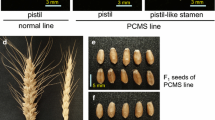Abstract
To investigate the cause of variation in the interspecific crossability of Brassica napus, three different genotypes were studied in respect of their reproductive behavior after pollination with B. juncea. There were great differences among maternal genotypes in allowing foreign pollen to germinate on and penetrate into their stigmas, leading to a wide diversity of interspecific fertilization. The division of the hybrid primary endosperm nucleus and zygote appeared normal in all combinations of crosses. While the abundant free nuclei of the endosperm developed properly and never became cellular, the embryos degenerated as early as 10 days after pollination when the cultivar Rucabo, which had the highest fertilization record with species of B. juncea, was involved. When 81007 was used as female parent, the endosperm grew a little but the embryo halted at the heart-torpedo stage. Lack of nourishment might be responsible for the observed embryo abortion. Among the sic hybrid combinations, the cross 84014A x Changyang hunagjie was the only one where endosperm tissue was observable and an abnormal embryo occurred prior to cellular endosperm formation. Apart from the three typical embryological features, significant variation was also demonstrated among each of the cross combinations. Genetic diversity appears to exist not only between varieties, but also within cultivars. In addition, methods for developing interspecific crossable lines are discussed.
Similar content being viewed by others
References
Boyle TH, Stimart DP (1986) Self incompatibility and interspecific incompatibility: relationships in intra-and interspecific crosses of Zinnia elegans Jacq. and Z. angustifolia HBK (Compositae). Theor Appl Genet 73:305–315
Boyle TH, et al. (1987) Influence of Zinnia angustifolia HBK genotype on embryonic and vegetative development of Z. angustifolia x Z. elegans. Jacq. interspecific hybrids. Theor Appl Genet 73:716–723
Brink RA, Cooper DC (1941) Incomplete seed failure as a result of somatoplastic sterility. Genetics 26:487–505
Chen NC, et al. (1983) Interspecific crossability among four species of Vigna food legumes. Euphytica 32:925–937
Dumas S, Knox RB (1983) Callose and determination of pistil viability and incompatibility. Theor Appl Genet 67:1–10
Esen A, Soost RK (1973) Seed development in Citrus with special reference to 2x x 4x crosses. Am J Bot 60:448–462
Hadley HH, Openshaw, SJ (1980) Interspecific and intergeneric hybridization. In: Fehr WR, Hadley HH (eds) Hybridization of crop plants. Am Soc Agron Crop Sci, Amer Inc, Wisconsin, USA, pp 135–159
Martin FW (1959) Staining and observing pollen tubes in the style by means of fluorescence. Stain Technol 34:125–128
Matsuzawa Y (1983) Studies on interspecific hybridization in the genus Brassica. II. Crossability in the interspecific cross, B. oleracea x B. campestris L. Jpn J Breed 33:321–330
Meng J (1987) Study advances on distant hybridization incompatibility in Brassica. Oil Crops of China 4:71–77
Meng J, Yi G (1988) Studies on the embryology of reciprocal crosses between Brassica napus and B. juncea. Sci Agric Sin 21:46–50
Meng J, Zhou J (1988) The interspecific compatibility of Brassica napus x B. oleracea. II. The influence of maternal genotypes on the pollen-pistil interaction. J. Huazhong Agric Univ 7:111–117
Mulcahy DL, Sari-Gorla M (1992) Gametophytic competition and plant breeding. In: Dattee Y, et al. (eds) Reproductive biology and plant breeding. Springer-Verlag, Berlin, pp 77–85
Nei M (1975) Molecular population genetics and evolution. North Holland Publishing Co., New York
Oettler G (1984) Parental effects on crossability, embryo differentiation and plantlet recovery in wheat x rye hybrids. Euphytica 33:233–239
Poysa V (1990) The development of bridge lines for interspecific gene transfer between Lycopersicon esculentum and L. peruvianum. Theor Appl Genet 79:187–192
Raghavan V (1976) Experimental embryogenesis in vascular plants. Academic Press, London, pp 319–339
Sharma HC, Gill BS (1983) Current status of wild hybridization in wheat. Euphytica 32: 17–21
Weaver JR (1957) Embryological studies following interspecific crosses in Gossypium. I. G. hirsutum x G. arboreum. Am J Bot 44:209–214
Wu J, Meng J (1992) The interspecific compatibility of Brassica napus x B. juncea and the screening of compatible genotypes. Sci Agric Sin 25:36–40
Wu SH, et al. (1965) On the fertilization of Oryza sativa L. x Sorghum vulgare Pers. Acta Bot Sin 13:297–313
Zamir D (1983) Pollen gene expression and selection: applications in plant breeding. In: Tanksley SD, Orton TJ (eds) Isozymes in plant genetics and breedings, part A. Elsevier Science, Amsterdam, pp 313–330
Zhen G (1978) Biology Microtechniques. People's Publ., Beijing, pp 79–109
Author information
Authors and Affiliations
Additional information
Communicated by H. F. Linskens
Rights and permissions
About this article
Cite this article
Meng, J., Lu, M. Genotype effects of Brassica napus on its reproductive behavior after pollination with B. juncea . Theoret. Appl. Genetics 87, 238–242 (1993). https://doi.org/10.1007/BF00223771
Received:
Accepted:
Issue Date:
DOI: https://doi.org/10.1007/BF00223771




